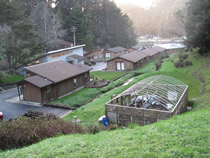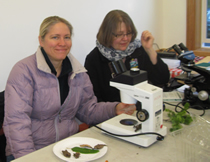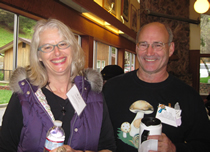All California Club Foray
January 22-24, 2016
What a terrific group of attendees for the seventh biannual All California Club Foray January 22-24, 2016 at the Albion Field Station in Mendocino County.
We were amazed that our new friends Henry Beker and Linda Davies flew all the way from Belgium and the UK, respectively, to attend this foray! Henry is an international expert on the genus Hebeloma, and we all met at the NAMA foray last fall in North Carolina. Also in attendance was Doug Smith, putting names to the several species of Galerinas that showed up, and scooping up some of the rarities for further analysis (some of the best material of a very unusual Hygrophorus that we (and most likely others) had ever seen: the gray capped waxy, Hygrophorus calophyllus in MDM; look for Doug's fine photos on Mushroomobserver.org).
Phil Carpenter and Henry Young were ever-present in our large,well-lit lab, cheerfully answering crowd questions and doing IDs, both in hand and in scope. Sava Krstic dove deeply in the several ascomycete collections that showed up to this foray, and spent a lot of scope time searching for good names, helping attendees in one on one tutorials and he also enlightened folks as to the wonders of ascos in our Sunday morning specimen table walk-about. And most especially, huge thanks to Peter Werner, who brought a bank of scopes that were heavily used by many all weekend long. We had one attendee who had never looked thorough a scope before; believe me, it won't be the last time he goes below the surface!
Sandi Smith brought in some still living mycelia, stuck to the bottom of a damp log, and we got to watch that world unfold underneath that amazing Leica optics dissecting scope: from teeny tiny wildlife in that fungal forest to variously colored droplets of goodness knows what, being produced by that living, moving and engaging mycelial mat! A world of wonder under our feet and beneath those woodpiles!
Let's be honest ... our woods and fields are all still in recovery mode, and the fungi were pretty darned scarce. But when you get almost 60 people hunting, and looking hard for interesting fungi and NOT just edible fungi, you get a lot of interesting material. Just to get those edibles out of the way ... only two fruit bodies of Craterellus calicornucopioides (new name for that same old local black trumpet) were found, there were scattered patches of yellow feet, a delicious, under-appreciated Craterellus sp., both sp. of those tasty hedgehogs or Hydnum, the bellybuttons and H. repandum, a few Cantharellus formosus, most rather waterlogged, a few candy caps and ZIP! for Boletus. Only two fleshy pored boletes came in ... both Suillus caerulescens. For most of the weekend, the only bolete representative on our tables was Phylloporus arenicola, the gilled bolete, and it kept getting moved onto the Agaric table by various, as of yet uninformed persons!
One of the more astounding finds were some HUGE versions of Galerina marginata, with caps so darned big that we could have easily killed off our entire foray with a mis-IDed meal! These Galerinas contain the same deadly toxins as do Death Caps and Destroying Angels. I have never seen them so big, but Doug, whose group this is, was unimpressed. Guess that I need to get out more.
I am not a truffler, but I am starting to see just why these little subterranean fungi can be so fascinating. Someone found a true Tuber sp., which I IDed as Tuber californicum. This Tuber has a pale peridium and a faint garlicky odor and some way-cool, fat sacs of asci under the scope. Peter Werner made us a gorgeous prep with Congo Red, and it was hard to tear your eyes away from that beautiful and fascinating slide!
Frankly, our attendees were every bit as interesting as our fungal collections. We had attendees from Ontario Canada, the Midwest (Minnesota and Kansas!) and the Pacific Northwest as well as all over California. Best of all, folks were really there to hands-on learn, and have fun while learning, rather than being focused on merely edible mushrooms and entertainment. One gal asked me about foray etiquette, and whether it was "OK" to even collect edibles! How funny is THAT? Ironically, we all had to obtain those stupid "commercial hunter" permits from JSF before we could collect legally in JSF. I have no problem donating funds to JSF to preserve those trees and land; I do resent being part of a "commercial hunter" database, when the exact opposite is true!
As luck would have it, we ran into the actual Jackson Demonstration State Forest manager while standing around Mushroom Corners. She was on her day off, and biking through the forest, and asked us about our time in "her" woods. All very friendly. We will continue to pursue this serendipitous contact in hopes of adding more reason to JSF mushroom policies. Turns out in their current incarnation, they are really not quite sure what to do with the various fungal species lists that some of us have been sending them. Surely we can help raise the bar for fungi to the north of the BA, as well as within it?
You know you are at a mushroom-centric foray when even the cabins are sprouting fungi: Peziza domicillus, large, pale brown cups, growing out of Hugh and Sandi's door frame! Good news for fungal fanatics, not so good news for property managers. We alerted the proper authorities.
AS always, our dear friends Hugh and Sandi showed their collecting group a rollicking good time in the woods. No wonder folks fight to go on their forays. Still, anywhere in the wet and gloriously green forest was a good time, and all I saw this past weekend were happy faces.
Mark your calendars for January 2018, when we do this super-fun and cushy, taxo-centric biannual foray all over again.
AAAAACCCCCCCCFFFFFFF! It's what you want.
Debbie Viess





